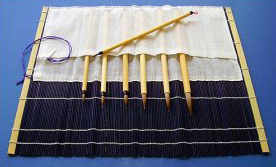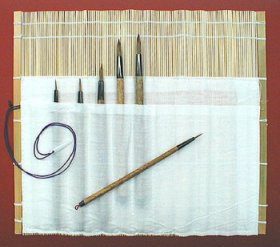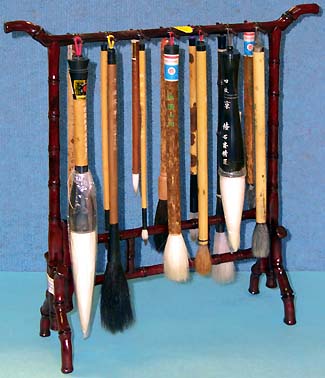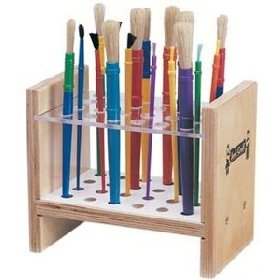Edit History:
- (2/1/2008): be sure to checkout i-paint's comment about new brush caps.
We have our own brushes now and it leads to questions about how to care for a brush.
The Glue
First of all, new brushes have glue in the tip to make them look all perfectly straight and beautiful when you buy them. This can also be used to conceal the quality of the brush since it looks great in the store and my act different when you start using it and the glue comes out. So just be cautious about that. Expect glue, but try not to get ripped off.
Soak your new brushes in water for about 10 or 15 minutes to get the glue out or they may act a little strange when you use them. For Example, my hard bristle brush was acting like a soft bristle brush (it didn't have any spring to it, it would bend and stay bent after each stroke).
Use Gently
I found that I was much to rough when rinsing and dabbing my brushes. You don't really think about these things when you're using the community materials in an art class or something, but you start to question more once you spend $20 or more on a brush.
When you rinse your brush in between strokes, DON'T push the brush all the way to the bottom of the container and bend or pound the tip. There's no reason for it. It's not getting the brush any cleaner and it's bending the bristles. I found that pounding the brush also made it difficult to get a perfectly thin straight tip.
Instead, dip the brush in the water, don't touch the bottom at all, and just swirl it around in a circle. Then, *touch* it to the side of the container a few times –don't *press* it to the side of the contain. After that go directly to your dabbing cloth. Again, don't press, bend, or pound the tip into the cloth. Instead hold the brush horizontally and touch the whole side of the tip to the cloth. You can also drag it a little and help all the bristles point in the correct direction. Rotate the brush between your fingers and do it again.
When you're done, you'll notice that the brush tip is pretty dry, as well as nice and narrow with a pretty nice, if not perfect, tip.
The same goes with your pallet, no need to be rough or over flex the brush.
Make it a habit, be gentle on the brush. I'm a big dumb guy, so I find myself pounding the brush into the rinse water like an ape with a stick. I have to really make a conscious effort to be gentle, but BELIEVE IT OR NOT, I find that when I'm rough on the brush I can't paint because I'm messing up the bristles and I'm unconsciously tensing up. As soon as I make a conscious effort to be gentle on the brush, the brush works better and I can't help but relax more, and suddenly I'm painting better. That's my favorite part so far. When you're doing it right, Chinese Brush Painting is calming and relaxing.
Putting them away
Rinse the brushes gently under some water, then PAT them dry WITH a towel (don't DAB them dry ON a towel).
You can leave them on a brush rest to air dry, but ultimately you want to either store them in a roll-up or hang them with the tips pointing down. In both cases, the idea is to get the tip to stay nice and straight.
I did a search on amazon, and here are a couple roll-ups like the one I have:
 |  |
Note, I can't vouch for those specific brushes because I've never used them :)
Also Note: those links go to "Sumi" Brushes. Sumi (or Sumi-e) is a Japanese style of brush painting. Here's what Wikipedia has to say about it.
http://en.wikipedia.org/wiki/Sumi-e
Here's what the stands look like (sorry, couldn't find any good amazon links)

If you store all your brushes by jamming them into a can or jar, odds are you're not doing the brushes much good. If the tip is aiming upward, then gravity will effect the bristles and bend them over time. If the tip is at the bottom, then it's probably bending under the weight of the brush.
So, if you love your brushes, DON'T use anything that looks like this:



















2 comments:
New brushes come from the store with a plastic cap. It is important to throw this cap as far away as possible. If you put it back, after using the brush, the hairs will mold.
You can use a bamboo brush-mat; but you can also use a sushi-roller or a bamboo place mat (price $1.25). The are essentially the same thing. Protects the brush and keeps it aired.
Don't be too gentle. While—for most operations—you want to keep the hairs parallel and pointed, sometimes you want to slam the brush straight down to the heel! and then drag it around. Go wild. Paint AGAINST the point to produce effects like rough tree-bark. Sometimes lay the brush flat and paint sideways…
A good sumi-e brush is not a $250 red sable watercolor brush. It is less expensive, more versatile and stronger. If it gets messed up, just hold it into water, and—voila!—it will regain it's shape.
Awesome! Thanks for the input!
Post a Comment